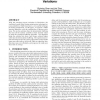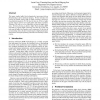TCAD
2008
14 years 7 months ago
2008
Recently, the microprocessor industry is headed in the direction of multicore designs in order to continue the chip performance growth. We investigate buffer insertion, which is a ...
ASPDAC
2007
ACM
14 years 11 months ago
2007
ACM
With the emerging process variations in fabrication, the traditional corner-based timing optimization techniques become prohibitive. Buffer insertion is a very useful technique fo...
DAC
1997
ACM
14 years 11 months ago
1997
ACM
Buffer insertion seeks to place buffers on the wires of a signal net to minimize delay. Van Ginneken [14] proposed an optimal dynamic programming solution (with extensions propose...
ICCAD
1999
IEEE
14 years 11 months ago
1999
IEEE
This paper studies buffer block planning for interconnect-driven floorplanning in deep submicron designs. We first introduce the concept of feasible region (FR) for buffer inserti...
ISPD
1999
ACM
14 years 11 months ago
1999
ACM
Buffer insertion is an effective approach to achieve both minimal clock signal delay and skew in high speed VLSI circuit design. In this paper, we develop an optimal buffer ins...
DAC
1999
ACM
14 years 11 months ago
1999
ACM
Buffer insertion has become a critical step in deep submicron design, and several buffer insertion/sizing algorithms have been proposed in the literature. However, most of these m...
ISPD
2003
ACM
15 years 13 days ago
2003
ACM
Previous works on buffer planning are mainly based on fixed die placement. It is necessary to reduce the complexity of computing the feasible buffer insertion sites to integrate t...
ISPD
2003
ACM
15 years 13 days ago
2003
ACM
— In order to achieve timing closure on increasingly complex IC designs, buffer insertion needs to be performed on thousands of nets within an integrated physical synthesis syste...
ASPDAC
2004
ACM
15 years 19 days ago
2004
ACM
As gate delays decrease faster than wire delays for each technology generation, buffer insertion becomes a popular method to reduce the interconnect delay. Several modern buffer in...
ASPDAC
2004
ACM
15 years 19 days ago
2004
ACM
As the process technology advances into the deep submicron era, interconnect plays a dominant role in determining circuit performance and signal integrity. Buffer insertion is one...


